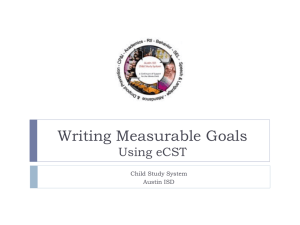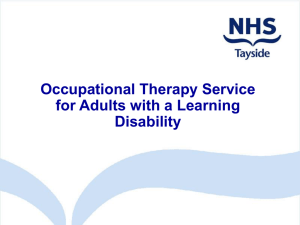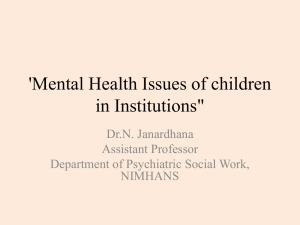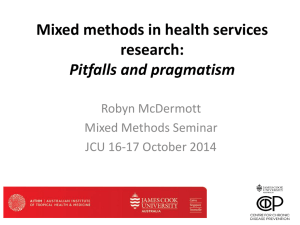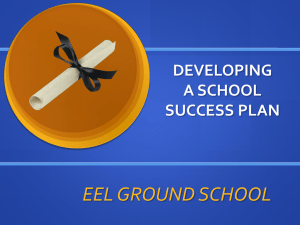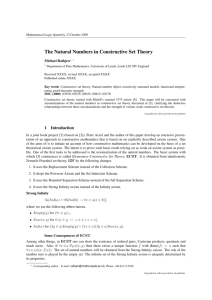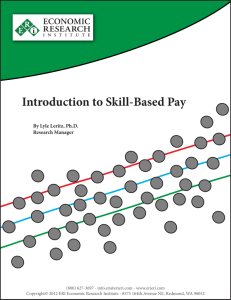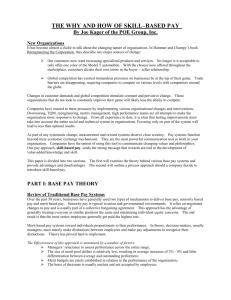Effective Goals.Summer
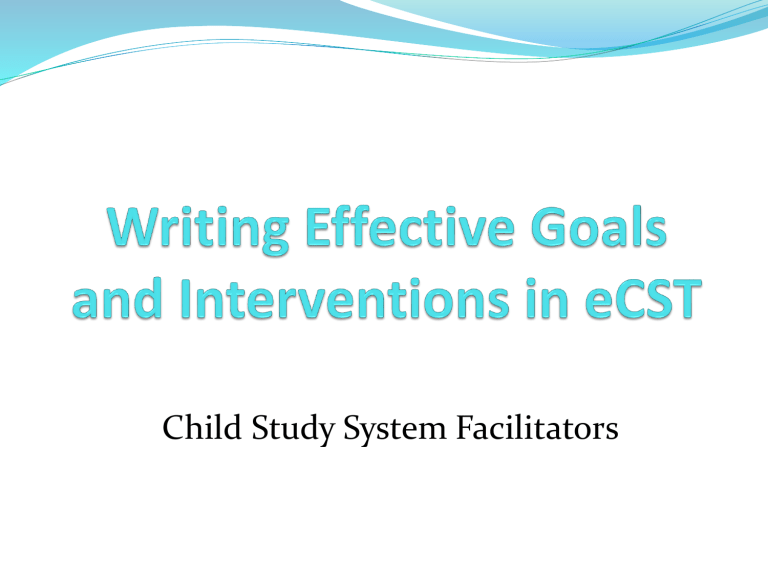
Child Study System Facilitators
Goals vs. Objectives
In general, goals are broad; objectives are specific
For the purpose of eCST, there’s no difference; the broad goal is to increase skills in a specific area—academic, behavior, or attendance
A goal in eCST might be an objective in another context
Don’t get bogged down in semantics
Why Does it Matter?
In order to know if we’re on the right track, we must know where we started and where we want to go.
A goal is a dream with a deadline.
-Napoleon Hill
Guiding Questions
What do we want the student to know or do?
What skills are missing? Why can’t the student do this now?
What CAN the student do now?
How is this relevant to this student’s learning?
How can we measure this knowledge, skill or behavior?
Intervention Plan: Analyze Data
Analyze Data
Monitor
Progress
Create
Skill-Based
Goal
Deliver
Focused
Intervention
Analyze Data
•
•
•
•
•
Kinds of Data Sources of Data
TAKS/STAAR • Student Level Review
Universal Screeners
(TPRI, Tejas Lee,
DIBELS, etc.)
•
• eCST
DEEDS
• SchoolNet
Benchmarks
• Aimsweb
Attendance Data
•
•
My Reporting
Discipline Data
ACCESS
Please see childstudysystem.com
for more information including detailed instructions for accessing specific AISD reports.
Intervention Plan: Create Goal
Analyze Data
Monitor
Progress
Create
Skill-Based
Goal
Deliver
Focused
Intervention
Writing
S.M.A.R.T.
Goals
S pecific—clearly focused; answers who, what, where, when, etc.
M easurable—establishes concrete criteria for measuring progress
A ttainable—reasonable chance of being achieved
R elevant—achievement will make a significant difference to the student’s ability to make progress
T imely—the goal has a begin date and time frames for progress monitoring and follow-up
(from the work of George T. Doran and Paul J. Meyer)
How Do I Determine the Goal?
Using data:
1.
Identify the highest skill the student CAN do and write a goal to measure the next step.
2.
3.
Determine a missing skill that would make a significant difference if achieved and write a goal to address that skill.
Identify a desirable behavior that would increase the student’s ability to be successful and write a goal to increase that behavior.
Two Ways to Create Goals in eCST
1.
Use drop down boxes to identify behavior type or
TEKS-based skill then edit to make it S.M.A.R.T
(screen shot)
Two Ways to Create Goals in eCST
2.
Write your own S.M.A.R.T. goal directly into the goal text box.
Include Measurement Method
DIBELS
Passports
Weekly curriculum assessments
Grade level word lists
Level system
Frequency count
Phonics cards
Writing rubric
Examples:
The student will … as measured by teacher made tests.
The student will … as measured by DIBELS.
The student will … as determined by a writing rubric.
The student will … as evidenced by point sheet.
Conditions: Define the Circumstances
BEFORE the goal:
Given a 4 th grade level text, the student will…
Given 2 or more acceptable choices, …
Using a graphing calculator, …
Or AFTER the goal:
… within 3 minutes
… using a visual cue or graphic organizer
… using manipulatives.
Determining “Success Threshold”
The “success threshold” in eCST means the performance level needed to show mastery or adequate progress toward the goal.
Success Threshold- Must Match
Measurement Type
Percentage Frequency
Assessment
Score
Scale
80% 3 weeks in a row
100% in 3 out of 4 attempts
4 of 5 attempts
Less than
2 times per day
DORF of
55 wpm or better
2 out of 4 on writing rubric
“Often” or better, 4 of 5 days
“Rarely” or better, 2 weeks in a row
Common Goal Writing Errors
Too broad to be measurable
Too many to be manageable
Too high to be achievable
Too low to make any difference
Example 1: Make it SMART
Adam will get better with adding and subtracting two digit numbers
Adam will determine the correct operation and solve problems requiring addition and subtraction of two-digit numbers with and without regrouping, with 80% accuracy, as measured on teacher made assessments.
Example Goal in eCST
1.
2.
3.
On your handout, review components of
SMART goals.
Find the table at the bottom.
Working with a partner, transform the “weak” goals into SMART goals in the space provided.
Example 2: Make it SMART
Danielle will improve her reading comprehension skills.
After reading a 5 th grade level text, Danielle will answer at least 4 out of 5 comprehension questions correctly on the weekly reading assessment.
Example 3: Make it SMART
Manuel will improve his study skills.
After assistance creating an organization system, Manuel will complete and turn in assigned work on time, as measured by scoring a weekly average of 3 or better on a 4 point teacher feedback sheet.
Example 4: Make it SMART
Lesley will behave in class.
Lesley will stay in her seat during academic work periods as measured by the student’s point sheet.
Lesley will refrain from making disruptive noises and sounds during classroom activities as measured by the student’s point sheet.
Things to keep in mind
Goals are skill based not grade level based.
Good goals are reasonable but ambitious.
Measure progress for 3-9 weeks, review fidelity and results, and adjust as needed.
Be judicious—each goal must be measured regularly.
Don’t overwhelm yourself with too many goals.
To measure progress, plan for multiple data points, gathered at least every other week. Measurements taken less frequently (MOYs or DRAs, for example) are not good tools for short term goals.
And the Biggest Thing to Remember
The Intervention Plan is all about the
INTERVENTIONS , not the goal.
The purpose of the goal is to measure the student’s response to your interventions.
Without good, quality interventions, implemented with fidelity, the goal is meaningless.
I Have a Goal—Now What?
Intervention Plan: Instruction
Analyze Data
Monitor
Progress
Create
Skill-Based
Goal
Deliver
Focused
Intervention
Providing Interventions
Research- or evidence-based
Directly linked to goal
Not simply a location (reading specialist, after school tutoring, etc.)
Includes frequency, duration, grouping ratio
Multiple interventions can support one goal
Interventions can change even if goal remains the same
Literacy Interventions
TPRI Interventions
SRA Corrective Reading
Great Leaps
REWARDS
Read Naturally
Achieve 3000
Learning A-Z
Portals
SIPPS
Ebbers Strategies
Wilson Reading
Read 180
Passports
Ticket to Read
Duet/Choral Reading
Six Minute Solution
Key 3 Routine Strategies
Tesoros de lectura
Project Read
My Reading Coach
Math Interventions
Envisions
Read it, Draw it, Solve it
Van de Walle Strategies
Moving with Math
Kathy Richardson
Strategies
Region XIII 2 nd , 5 th , 8 th
Sense Strategies
Hands on Standards
Holt Additional
Resources
Meadows Center
Modules
America’s Choice
Mathematics Navigator
TEMI Intervention
Resources
Region IV Strategies
Behavior Interventions
Success Chart
Behavior Contract/Point
Sheet
Level System
Social Skill Group
2:10 Intervention
Back and Forth Journal
Self-Control Strategies
Visual Schedule
Self-Management Group
Cool Down/Recovery
Space
Check in/Check out
Pre-Correction
Degree of Choice
Partner with CIS
Problem Solving
Instruction
Intervention Plan: Monitor Progress
Analyze Data
Monitor
Progress
Create
Skill-Based
Goal
Deliver
Focused
Intervention
Determining “When Observed”
The when observed field indicates when progress monitoring will occur. Is progress monitoring taking place during a particular class, during an after-school intervention or pull out group, or during a specified assessment?
For behavioral goals, it may be helpful to observe progress throughout the day.
Determining “Summary Period”
The summary period indicates how often you plan to progress monitor- daily, weekly, other period
Multiple data points are necessary in order to measure progress- gathered at least every other week.
Behavior progress monitoring may be needed more frequently than academic monitor- we recommend daily.
Document Progress
Progress monitoring in eCST
Include multiple data points
Review progress regularly (3-9 weeks)
Adjust intervention as needed based on data
Frequency
Intensity
Duration
Develop new intervention if needed
w
Okay. I’ve created an intervention plan and collected data.
Now what?
Intervention Plan: Review Data
Analyze Data
Monitor
Progress
Create
Skill-Based
Goal
Deliver
Focused
Intervention
Data-Based Decision Making in RtI
Adapted from Beyond the RtI Pyramid by William Bender
Possible Data
Outcomes
Possible Decisions on Future Interventions
Data chart shows great success, and child is now on grade level or meeting benchmarks.
Discontinue the intervention; child continues participation in general education.
Data chart shows some success, but child is not yet on grade level or meeting benchmarks.
Continue the intervention for an additional grading period; child continues participation in general education.
or
Modify intensity of the current intervention without otherwise changing it.
or
Move child to a more intensive intervention and continue participation in general education.
Data chart shows little positive growth on targeted skills.
Move child to a more intensive intervention, and continue participation in general education.
or
Consider moving the child forward toward a child study team meeting for more intensive staffing or possible eligibility for special education services.
Review Data (3-9 weeks)
Review progress monitoring data
Review fidelity of implementation
May increase/decrease frequency, duration
May add additional intervention
May change current intervention
May discontinue intervention and return to Tier 1
If Insufficient Response Continues
Refer to Child Study Team (CST)
Make request through eCST (Service Tracking)
CST will meet to:
Review current interventions
-
-
-
Review progress monitoring
May consider additional interventions
May consider referral to social service specialist
May consider request for additional assessment
(dyslexia, 504, special education, etc.)
For Additional Help and Information
Child Study System website—childstudysystem.com
eCST Resource Links
Child Study System
Facilitators
Professional Development
(CSS or RtI)
CST chair or team
Pre-Referral Intervention
Manual, Stephen McCarney
Campus Specialists
Academic Coaches
Other colleagues
AISD Response to Intervention website— austinschools.org/curriculum/RtI/index.html
